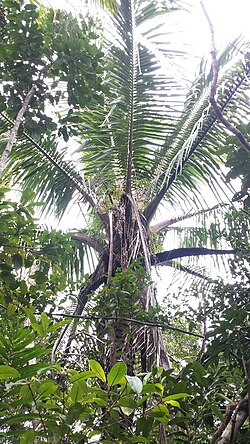Biology:Voanioala
| Voanioala | |
|---|---|

| |
| Scientific classification | |
| Kingdom: | Plantae |
| Clade: | Tracheophytes |
| Clade: | Angiosperms |
| Clade: | Monocots |
| Clade: | Commelinids |
| Order: | Arecales |
| Family: | Arecaceae |
| Subfamily: | Arecoideae |
| Tribe: | Cocoseae |
| Genus: | Voanioala J. Dransf. |
| Species: | V. gerardii
|
| Binomial name | |
| Voanioala gerardii J. Dransf.
| |
Voanioala gerardii, commonly known as the forest coconut, is a species of flowering plant in the family Arecaceae. It is a relative of the coconut, and is generally regarded as monotypic within the genus Voanioala. However, a team of geneticists headed by Bee F. Gunn found sufficient genetic variation within Voanioala to constitute at least two and possibly four cryptospecies.[3] Voanioala is endemic to Madagascar , and is threatened by habitat loss. Voanioala is harvested for its edible seeds and palm heart. It is estimated that there are fewer than 15 mature trees remaining.[1]
Description
The forest coconut is a Madagascan tree that can reach 15–20 meters high in the wild. It is supported by a strong root base, and its leaves sprout from the crown. Voanioala can reach up to 5 meters in height. The leaflets are waxy, green, and stiff, and seventy of them can grow from each side of a leaf. The fruit grows in groups at the crown with a thick reddish-brown color. Each seed is up to 2.8 inches (7 cm) long and 1.5 inches (3.5 cm) thick and is longitudinally grooved.[4] A scientifically remarkable trait is that each cell has about 600 chromosomes, which is extraordinary for a monocotyledon.[5]
Distribution
Voanioala gerardii is endemic to Madagascar, and is found in only the Bay of Antongil of the Masoala Peninsula, in the northeastern area of the island. It is extremely rare.[1][5]
Habitat
The forest coconut is found in the bottom of swampy valleys, as well as slopes in rainforests[5] at an elevation of 200–450 meters above sea level.[6]
Conservation
Voanioala gerardii is critically endangered because of its scarcity. Only 10-15 trees are found. They are cut down for their edible palm hearts, and their seeds are used for market trade. They are also rare because of its poor dispersal of seeds. Habitat loss through agricultural logging threatens forest coconuts as well.[1] The national park in Masoala Peninsula protects the forest coconuts on its property, and its future depends greatly on the effort of the national park.[5] Its population is currently decreasing.[1]
References
- ↑ 1.0 1.1 1.2 1.3 1.4 Rakotoarinivo, M.; Dransfield, J. (2012). "Voanioala gerardii". IUCN Red List of Threatened Species 2012: e.T38723A2883819. doi:10.2305/IUCN.UK.2012.RLTS.T38723A2883819.en. https://www.iucnredlist.org/species/38723/2883819. Retrieved 14 November 2021.
- ↑ "Appendices | CITES". https://cites.org/eng/app/appendices.php.
- ↑ Gunn, Bee F. (2004). "Phylogeny of Cocoeae (Arecaceae)...etc". Annals of the Missouri Botanical Garden 91 (3): 509.
- ↑ Larry R. Noblick in The Palm Journal # 212 (Fall 2016) pp. 12 & 13 Figs 1 & 3.
- ↑ 5.0 5.1 5.2 5.3 "Forest Coconut". http://www.arkive.org/forest-coconut/voanioala-gerardii/.
- ↑ "Voanioala gerardii". http://www.virtualherbarium.org/psg/flagship/Voanioala-gerardii.html.
External links
Wikidata ☰ {{{from}}} entry
 |


